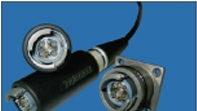Fiber-optic advancements

Telecast Fiber Systems’ four-core MX expanded beam plug and receptacle is a standard for harsh environments.
The evolution of fiber optics has made it possible to achieve far greater signal capacity than was ever possible when the technology was first introduced in the late 1970s. But while fiber optics is not fundamentally a complex subject, the rapid, sometimes uncoordinated development of the industry has unnecessarily increased the level of complexity. The existence of some 80 different connectors and all sorts of fiber types speaks to this trend.
In addition, thanks in part to the increasing popularity of bandwidth-heavy HDTV signals and to lack of foresight, early fiber installations are already overwhelmed and being tasked to handle far more signals than they were built for. From this quandary has emerged more cost-effective electrical and optical signal multiplexing techniques that allow us to get more signals onto less cores while facility managers and broadcasters find ways to pull in more glass.
Now that the fiber-optic industry is beginning to mature, there is a greater need for manufacturers to dedicate effort to identifying what methods work best in broadcasting applications and move toward developing techniques that reduce the artificially elevated level of complexity. An industry-wide adoption of the same fiber cabling and connectors will make it easier for mobile broadcasters to have access to compatible equipment, maintain spare parts reserves, find qualified technicians and ultimately keep the equipment clean and working. Paramount to this is settling on cable types, fiber counts and connectors that allow the availability, durability and compatibility that you, as remote broadcast engineers, demand.
Wavelengths and multiplexing
For many years, data transmissions over fiber networks used the same 1550nm wavelength that telephony companies also use. The 1550nm optical window is attractive in telephony applications because it propagates well over long distances, and cables tend to be permanently installed. However, in the far more demanding operating environment of remote broadcasting, this operating wavelength has been less than ideal when using single-mode fiber cables because it is more susceptible to losses from tight corners and microbending — small bends at the microscopic level that create additive optical losses along a given cable length. But, of course, as soon as we make a sweeping statement like that, new fiber technologies promise to overcome these limitations.
In contrast, 1300nm window wavelengths are more stable, making them better suited for use in mobile broadcast fiber installations. The 1550nm wavelength would not have been used in these applications if not for one reason: the need to optically multiplex multiple signals onto a single strand of fiber. Because the 1550nm and 1310nm wavelengths don't interfere with each other while in the glass, both can occupy the same fiber strand without problem, allowing networks to double up on the number of signals that can be sent down a fiber.
With the advent of coarse wavelength division multiplexers (CWDM), it's possible to send eight signals down a cable within the 1300nm window. If we then add eight more wavelengths ranging up to the 1550nm window, our signal payload increases.
Connector advancements and cable core counts
There are many different connector types available. But just like restaurants in New York City, the good ones flourish and the bad ones don't last long. For single fibers, the ST has offered the best combination of durability and cost for many years. The fact that it looks a lot like a BNC makes it a favorite among broadcasters. But patching lots of STs together in long fiber runs is not efficient, so we set out to find a multi-core connector that was tough and relatively foolproof. The Delphi hermaphroditic connector, in four- and 12-core counts, was an easy choice. The SMPTE committee thought so too, making it a standard for harsh environments.
Now, more than a decade later, the pin and socket design of the Delphi is being supplanted by the even more advanced expanded beam connector technology that uses lenses flush with the mating plane so that there are no longer recesses that can trap dirt and other contaminants. These MX connectors promise even higher performance, tool-less cleaning, easy maintenance, smaller size and, ultimately, lower cost. They will be available in two- and four-fiber configurations.
Fiber core counts are also a critical consideration when building your system. The trick is to design in enough cores to cover your requirement and still have capacity for some spares and/or redundancy while incorporating connectors that are reliable and maintainable. For trunking applications, we created configurations using 12-fiber cables and connectors. But with the emergence of CWDM, we now can easily transport more signals on less cores. So, standardizing on two- and four-core fiber cables with hermaphroditic expanded beam connectors offers a solution that dramatically reduces costs and complexity.
Pulling the pieces together
New fiber technologies combined with new connectors and advanced electronics are making remote broadcasting jobs easier. Further standardization on the use of CWDM with two- and four-core expanded beam connectors for additional redundancy will boost the ability of fiber optics to support a high volume of signals while eliminating the limitations that previously plagued high-bandwidth signal transport over copper. Once these elements are accepted on a wide-scale basis — and incorporated into existing and future systems and rental inventories — we will all benefit with quicker setups and strikes; easier cleaning, maintenance and troubleshooting; more efficient signal transport; and significantly less expensive repairs in the event of unavoidable cable damage. This translates into fiber-optic systems that are better, faster and cheaper. As the fiber-optic industry continues to mature, the push for standardization on best-of-breed solutions will fundamentally benefit all broadcasters.
Joe Commare is vice president of sales and marketing for Telecast Fiber Systems.
Get the TV Tech Newsletter
The professional video industry's #1 source for news, trends and product and tech information. Sign up below.
